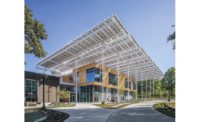ENR Southeast's 2020 Best Projects
Best Green Project: Kendeda Building for Innovative Sustainable Design

Kendeda Building for Innovative Sustainable Design
PHOTOS BY JONATHAN HILLYER

Kendeda Building for Innovative Sustainable Design

Kendeda Building for Innovative Sustainable Design

Kendeda Building for Innovative Sustainable Design

Kendeda Building for Innovative Sustainable Design





Kendeda Building for Innovative Sustainable Design
Atlanta
Project Of The Year Finalist And Best Project
Owner: Georgia Institute of Technology
Lead Design Firms: Lord Aeck Sargent, a Katerra Company; Miller Hull Partnership
Contractor: Skanska USA Building Inc.
Structural Engineer: Uzun+Case
MEP Engineer: Newcomb & Boyd
Contractors love a technical challenge, especially if they can learn something new and helpful along the way. And few projects fit that criteria better than the Kendeda Building for Innovative Sustainable Design at Georgia Tech in Atlanta.
Commissioned to demonstrate the feasibility of a regenerative, cost-effective green building in a region known for temperature extremes, the 47,000-sq-ft, net-energy-positive building generates more energy than it uses through a high-efficiency design that includes more than 900 rooftop solar panels. Pervious surfaces and bioswales surrounding the building naturally treat gray water. And the building contains a rainwater-to-potable-water treatment system that begins with rooftop rain collection.
The Kendeda Building also is the first global example of using salvaged materials in a mass timber project, incorporating nearly 500 nail-laminated panels crafted from salvaged 2x6s and 2x4s previously used for local movie and TV productions.
Jimmy Mitchell, sustainability engineer for Skanska USA, the project’s construction manager, explains that salvage opportunities did not drive Kendeda’s design. “At the schematic phase, we took the architects’ designs and started looking around the community for possibilities,” Mitchell says.
One go-to source for possible salvage materials was the nonprofit Atlanta Lifecycle Building Center, which provided discarded movie set components as well as slate shingles suitable for reuse in shower and restroom walls and floors. Recently demolished campus buildings revealed late-19th-century heart-pine joists that were eventually milled for a monumental staircase.
Ultimately, Kendeda’s design incorporated 28 strategies for reusing salvaged materials, more than tripling the stringent reuse requirements of the Living Building Challenge, a holistic approach to sustainable design and construction based on actual performance.
“From the outset, everyone was excited about the project and seeing what was possible.”
– Jimmy Mitchell, Sustainability Engineer, Skanska USA
The project team was also challenged with preventing toxic and environmentally harmful materials on the International Living Future Institute’s Red List from making their way into the construction process. Applying a two-step due-diligence evaluation, the project team enlisted the expertise of many consultants to screen more than 1,000 materials for potential issues.
Mitchell says the team’s extensive research helped keep material selection in sync with Kendeda’s finite construction budget. For example, the galvanizing process for ductwork sheet metal often includes chromium VI, a Red List chemical used primarily for aesthetics. An additive-free sheet metal alternative was available, but the smallest increment was a 40,000-lb coil. Modifying all of Kendeda’s sheet metal designs to a single gauge enabled the team to make the most of its bulk purchase.
“We wound up using about three-quarters of the roll, giving us some leftover material for punch list items,” Mitchell says, adding that the use of modeling technology and other tools for deep analyses proved instrumental in weighing alternative approaches.
“It also meant that some decisions could be made later, which minimized the potential of having to do rework in case something didn’t work out,” he says.
The team’s meticulous approach resulted in the Kendeda Building meeting both its schedule and budget goals, with a final construction cost of $19.9 million. Since its opening, the building has hosted more than 100 events.
It also provides Georgia Tech students, researchers and visitors with a living laboratory of innovative yet practical alternatives to sustainable design and construction, from the radiant cooling and heating piping concealed beneath polished concrete floors to a rooftop garden featuring a honeybee apiary and blueberry orchard.
While not every project presents Kendeda-level design and construction objectives and opportunities, Mitchell says awareness is often enough to add a significant, if unexpected, sustainability difference to even the most routine projects. He cites a recent road reconstruction project that uncovered cobblestone pavers from more than a century ago. The cobblestones were donated to the Lifecycle Building Center and are now being used by a nonprofit dedicated to conserving Atlanta’s urban forest.
Regardless of the project’s scope or scale, teamwide collaboration is the fundamental element for success.
“From the outset, everyone was excited about the project and seeing what was possible,” Mitchell says of the Kendeda Building, “If we hadn’t been an integrated team, it would have fallen apart.”
Return to Southeast Best Projects Award Winners Stand Tall in 2020









